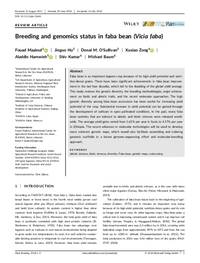Breeding and genomics status in faba bean (Vicia faba)

Authors:
Faba bean is an important legume crop because of its high‐yield potential and nutrition‐dense grains. There have been significant achievements in faba bean improvement in the last four decades, which led to the doubling of the global yield average. This study reviews the genetic diversity, the breeding methodologies, major achievement on biotic and abiotic traits, and the recent molecular approaches. The high genetic diversity among faba bean accessions has been useful for increasing yield potential of the crop. Substantial increase in yield potential can be gained through the development of cultivars in open pollinated conditions. In the past, many faba bean varieties that are tolerant to abiotic and biotic stresses were released worldwide. The average yield gains varied from 1.65% per year in Syria to 4.17% per year in Ethiopia. The recent advances in molecular technologies will be used to develop more coherent genetic maps, which would also facilitate assembling and ordering genomic scaffolds in a future genome‐sequencing effort and molecular‐breeding approach.
